I have been, or can be if you click on a link and make a purchase, compensated via a cash payment, gift, or something else of value for writing this post. As an Amazon Associate, I earn from qualifying purchases. Please read my full Affiliate Disclosure for more information.
Have you ever wondered how to create a space that feels both effortlessly elegant and deeply calming? Modern wabi sabi interiors have become increasingly popular because they celebrate imperfection, authenticity, and the beauty of natural materials—transforming everyday spaces into tranquil retreats. This aesthetic resonates with those seeking a mindful approach to design, emphasizing subtlety and understated charm over flashy trends.
In this article, you’ll discover a wealth of inspiration and practical ideas to bring the essence of wabi sabi into your home. From embracing weathered textures and earthy tones to incorporating handcrafted accents and thoughtful clutter-free arrangements, you’ll learn how to cultivate a space that exudes quiet sophistication and genuine warmth. Whether you’re new to the concept or looking to refine your current style, these ideas will help you craft a modern interior that radiates subtle elegance and authenticity.
1. Embrace Imperfect Textures with Natural Fabrics and Linens

In the world of modern wabi sabi interiors, celebrating imperfection through textures is a cornerstone of authentic serenity. Using natural fabrics and linens adds a tactile richness and visual depth that evoke a sense of calm and authenticity, making your space feel warm and inviting.
Recommended Products to replicate this idea
| # | Preview | Product | |
|---|---|---|---|
| 1 |

|
Bedsure 100% Cotton Muslin Throw Blanket Large 50x70 Inches - 4-Layer Breathable and Lightweight... | Check Latest Price |
| # | Preview | Product | |
|---|---|---|---|
| 1 |

|
Thmyo 4-Pack 100% Cotton Comfortable Solid Decorative Throw Pillow Case Square Cushion Cover... | Check Latest Price |
Imagine draping a slightly wrinkled linen throw in soft beige over a minimalist sofa, its subtle creases adding character. Textured cotton cushions with uneven weaving catch the light differently and invite touch.
Natural fabrics like burlap, hemp, or raw silk contribute an unrefined charm, while their earthy tones create a soothing, organic palette. These textures subtly break the sleekness of modern design, emphasizing beauty in flaws and irregularities.
The overall effect is a space that feels lived-in and genuine, with a gentle sensory experience through soft tactile surfaces. To incorporate these textures effortlessly, start by choosing linen or cotton textiles in neutral shades such as stone, cream, or muted gray.
Mix and match different textiles—think a woven throw, textured pillow covers, or a soft linen curtain—to add layers of tactile interest. You can find affordable options at local markets or specialty shops, or even repurpose vintage linens for a truly authentic look. Simply arrange these fabrics in your living space, ensuring they look casually placed rather than overly coordinated, to enhance the imperfect, natural aesthetic that defines wabi sabi.
2. Incorporate Weathered Wood Furniture for a Timeless Look
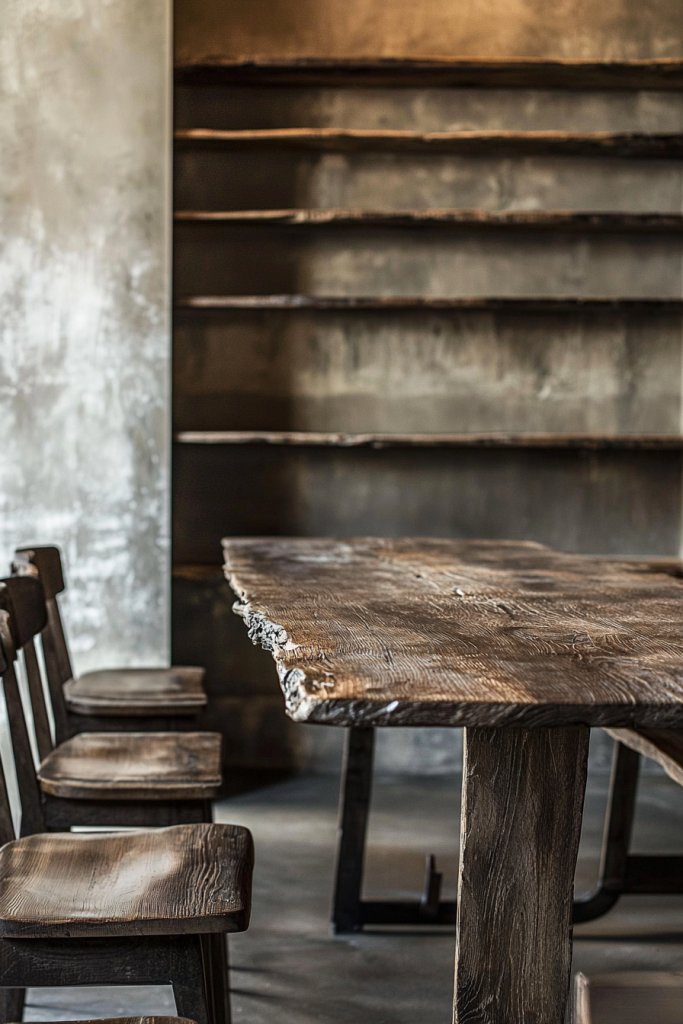
Weathered wood furniture embodies the wabi sabi principle of beauty in age and imperfection, offering a tactile and visual connection to nature’s cycles. Its worn, matte surfaces and irregular grains evoke stories of time, adding character and depth to modern interiors.
Recommended Products to replicate this idea
| # | Preview | Product | |
|---|---|---|---|
| 1 |

|
Wnutrees 43" Farmhouse Solid Wood Coffee Table, Rustic Rectangular Center Table for Living Room,... | Check Latest Price |
| # | Preview | Product | |
|---|---|---|---|
| 1 |

|
Decorative and Distressed Wooden Sideboard Storage Cabinet Cupboard with adjustable shelves, 4... | Check Latest Price |
Picture a reclaimed oak coffee table with chipping paint and uneven edges, its surface textured with cracks and knots. A vintage wooden sideboard with faded paint and visible grain patterns anchors the room with its rustic charm.
These pieces radiate a sense of history and authenticity, blending seamlessly into minimal settings while providing visual interest. The matte finishes and natural imperfections create a calming, grounded atmosphere, where furniture feels more like a living organism than mass-produced decor.
To achieve this look, seek out reclaimed or distressed wood furniture at thrift stores, flea markets, or through local artisans. If you prefer new pieces, opt for those with natural or matte finishes that mimic weathered effects—look for raw, unpolished surfaces or lightly distressed treatments.
Keep the focus on simplicity: a sturdy, unadorned table or bench with visible grain and irregularities will serve as a statement piece. Pair with neutral textiles and minimal accessories to let the weathered wood shine and evoke the timeless, imperfect beauty central to wabi sabi design.
3. Opt for Minimalistic Decor with Simple, Unadorned Shapes

In wabi sabi interiors, less is more. Choosing minimalistic decor with simple, unadorned shapes allows the natural beauty of materials and textures to take center stage, creating a space of subtle elegance and contemplative calm.
Recommended Products to replicate this idea
| # | Preview | Product | |
|---|---|---|---|
| 1 |

|
DOWAN 22 OZ White Ceramic Bowls Set of 4 - Perfect for Soup Bowls for Kitchen, Cereal Bowl, Ramen... | Check Latest Price |
| # | Preview | Product | |
|---|---|---|---|
| 1 |

|
Mitt&Ditt Ceramic Flower Vase, 5.3 inch Off-White Farmhouse Rustic Vase, Handcrafted Weathered... | Check Latest Price |
Imagine a sleek, low-profile concrete vase with clean lines holding a single, muted dried branch. Or a set of ceramic bowls with gentle curves and matte finishes, arranged in an asymmetrical but balanced composition.
These objects are unpretentious, emphasizing form and material over ornamentation, inviting quiet appreciation. The overall effect is a clutter-free space where each piece has purpose and meaning, fostering mindfulness and tranquility.
To achieve this aesthetic, select decor items that feature simple geometric shapes—think round, rectangular, or organic forms—made from natural materials like ceramic, stone, or unpolished metal. Avoid overly ornate or flashy items; instead, focus on quality craftsmanship and understated design.
Keep surfaces clear of excess accessories, and arrange objects with care to create a balanced, harmonious visual. This approach encourages a serene environment where beauty is found in simplicity and authenticity.
4. Integrate Handcrafted Ceramic Vessels and Pottery
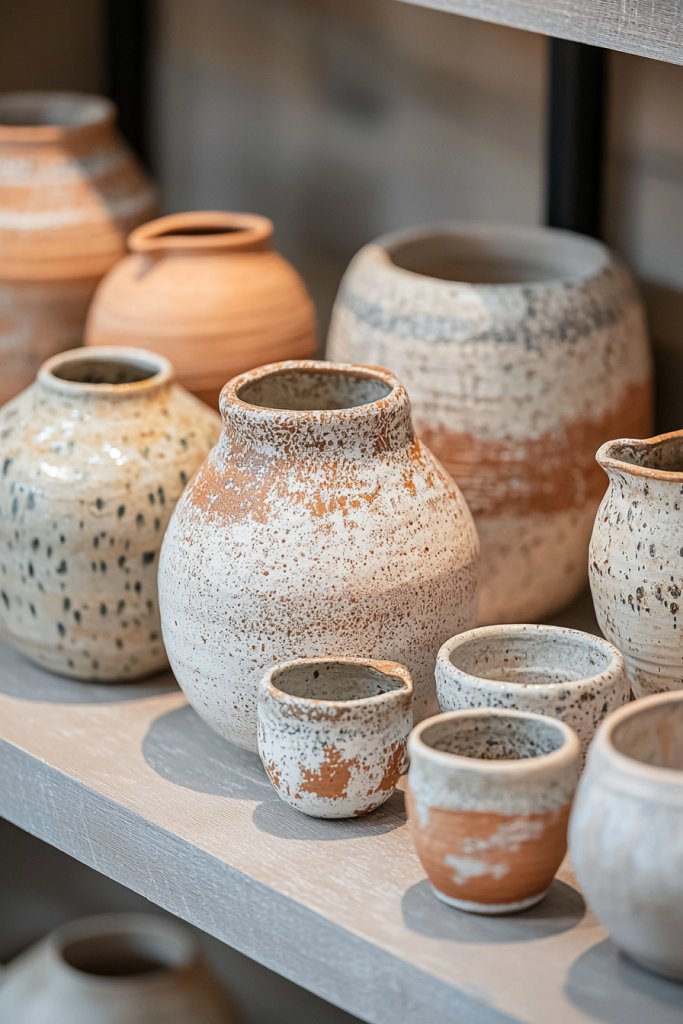
Handcrafted ceramic vessels and pottery are quintessential to modern wabi sabi interiors, showcasing the imperfect artistry and organic textures that celebrate craftsmanship and individuality. These pieces add warmth, tactile interest, and subtle imperfections that embody the philosophy of embracing flaws.
Recommended Products to replicate this idea
| # | Preview | Product | |
|---|---|---|---|
| 1 |

|
Vanselia Ceramic Flower Vase Home Decor - Large Farmhouse Table Vases Rustic Vintage Living Room... | Check Latest Price |
| # | Preview | Product | |
|---|---|---|---|
| 1 |

|
Pfaltzgraff Monroe Blue Serving Bowl, 9-Inch | Check Latest Price |
Visualize a collection of hand-thrown bowls with uneven rims, glazed in muted earth tones like warm terracotta, soft gray, and matte black. A tall, textured ceramic vase with an irregular surface holds a single dried flower or twig, adding an organic focal point.
Each piece feels unique, with slight variations in shape and glaze, reflecting the human touch and natural imperfections. The muted colors and rough textures create a calming, understated elegance that complements simple, natural interiors.
To incorporate these vessels, seek out artisans at local markets or online shops specializing in handcrafted ceramics. Start with a few versatile pieces—such as a large serving bowl, a minimalist vase, and a small planter—in neutral or earthy hues.
They can be paired with natural textiles or placed on open shelving or tabletops for visual interest. These ceramics are often affordable and durable, making them accessible ways to bring soulful, imperfect beauty into your home while supporting artisanal craftsmanship.
5. Showcase Asymmetrical Arrangements for Visual Balance

In modern Wabi Sabi interiors, embracing asymmetry creates a natural, effortless beauty that feels authentic and calming. Instead of perfectly matched or symmetrical decor, intentionally uneven arrangements evoke a sense of organic imperfection that resonates deeply with Wabi Sabi principles.
Recommended Products to replicate this idea
| # | Preview | Product | |
|---|---|---|---|
| 1 |

|
Vanselia Ceramic Flower Vase Home Decor - Large Farmhouse Table Vases Rustic Vintage Living Room... | Check Latest Price |
| # | Preview | Product | |
|---|---|---|---|
| 1 |

|
QEEIG Bathroom Floating Shelves for Wall - 15.7" Wall Mounted Shelf Over Toilet Farmhouse Home... | Check Latest Price |
Imagine a shelf or coffee table styled with a collection of pottery, books, and small sculptures arranged in a slightly off-center, unbalanced way. The objects vary in height, shape, and texture—perhaps a tall, narrow vase paired with a squat, rounded bowl, and a delicate ceramic figurine.
The overall layout feels spontaneous yet thoughtfully curated, inviting the eye to explore the subtle differences. Muted earth tones and matte finishes reinforce the understated elegance, while the irregular spacing creates visual interest without chaos.
The space feels grounded, authentic, and serene, emphasizing natural imperfection. To recreate this look, start by gathering a variety of objects—ceramic vessels, baskets, or small sculptures—with different heights and shapes.
Arrange them on a surface like a shelf, tray, or side table, intentionally placing some items slightly off-center or unevenly spaced. Trust your instincts, and don’t be afraid to experiment until the composition feels balanced in its asymmetry. Keep the color palette muted and natural, and avoid overly symmetrical patterns to maintain the organic, Wabi Sabi aesthetic.
6. Select Low-Profile, Comfortable Seating with Organic Lines

In Wabi Sabi interiors, furniture that emphasizes comfort and natural forms enhances the sense of tranquility and subtle elegance. Low-profile seating with flowing, organic shapes invites relaxation while celebrating imperfect beauty.
Recommended Products to replicate this idea
| # | Preview | Product | |
|---|---|---|---|
| 1 |

|
Meditation Floor Pillow Set of 2, Square Large Pillows Seating for Adults, Tufted Corduroy... | Check Latest Price |
| # | Preview | Product | |
|---|---|---|---|
| 1 |

|
King Size Bed Frame, Boucle Upholstered Platform Bed Frame with Soft Headboard, Sofa-Style... | Check Latest Price |
Picture a low, plush sofa or floor cushions made from soft, natural fabrics like linen or cotton in neutral shades—creamy beiges, warm taupes, or gentle greys. The furniture features rounded edges and gentle curves that mimic the natural world, avoiding harsh angles or overly structured designs.
The textures feel inviting to the touch, with a slightly worn-in appearance that adds character. Arranged in an open, inviting layout, these pieces foster a cozy, lived-in atmosphere that encourages pause and reflection.
The overall look is simple yet sophisticated, with a focus on tactile comfort and organic forms. To implement this, choose low-profile seating such as a futon, a sectional sofa with rounded arms, or a handful of floor cushions in muted tones.
Look for pieces with organic curves or handcrafted details—these often come from artisans or are DIY-friendly. For added comfort and authenticity, layer with textured throws like chunky knit blankets or soft linen covers.
Keep the arrangement open and inviting, ensuring enough space for easy movement. This approach creates a welcoming, relaxed environment that embodies the Wabi Sabi ethos of understated, natural elegance.
7. Focus on Clutter-Free Surfaces with Meaningful, Carefully Chosen Items
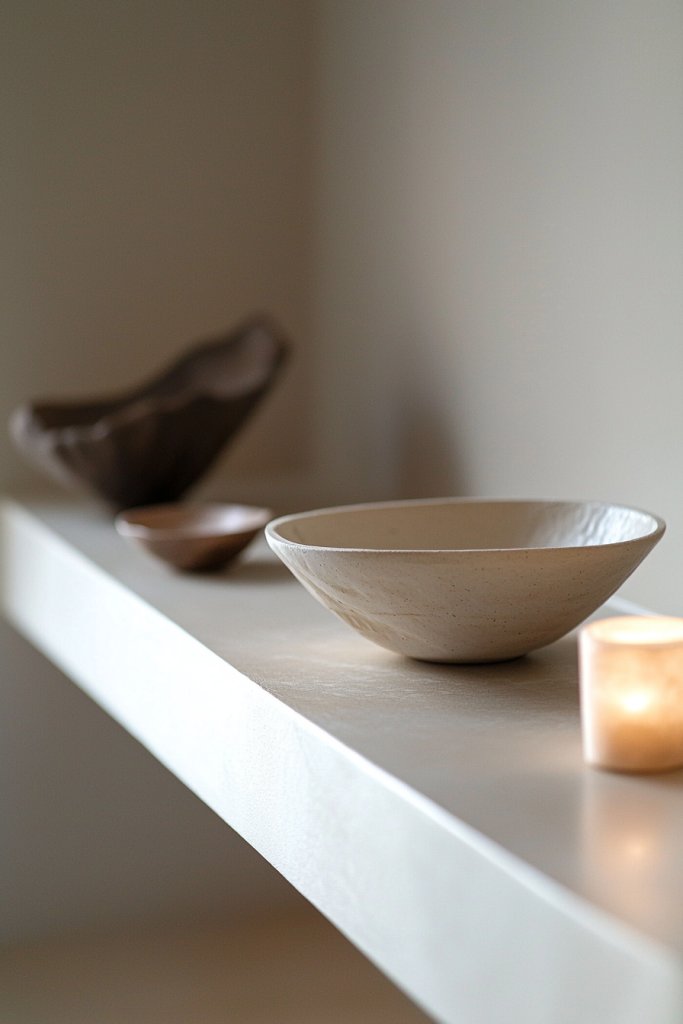
A key element of modern Wabi Sabi interiors is maintaining clean, uncluttered surfaces that showcase quality over quantity. Carefully curated objects that hold meaning and beauty contribute to a tranquil, harmonious space.
Recommended Products to replicate this idea
| # | Preview | Product | |
|---|---|---|---|
| 1 |

|
DOWAN 22 OZ White Ceramic Bowls Set of 4 - Perfect for Soup Bowls for Kitchen, Cereal Bowl, Ramen... | Check Latest Price |
| # | Preview | Product | |
|---|---|---|---|
| 1 |

|
Happyiren Cute Woven Storage Basket with Handle, Baskets for Gifts Empty, Gift Baskets for... | Check Latest Price |
Visualize a tabletop or shelf with only a handful of items—perhaps a handcrafted ceramic bowl, a small, textured sculpture, or a simple woven basket—all thoughtfully placed. Each piece is chosen for its tactile and visual appeal, with muted colors, matte finishes, and organic shapes.
The arrangement is deliberate, leaving plenty of negative space around each object to highlight its presence. The overall effect is calming, with surfaces that feel open, balanced, and free from chaos.
The space invites mindfulness and appreciation for each carefully selected item, embodying Wabi Sabi’s celebration of simplicity and imperfection. To achieve this, declutter regularly and select only objects that evoke emotion or have a story—things that are imperfect, aged, or handcrafted.
Use trays or shallow bowls to contain smaller items and keep surfaces tidy. Focus on quality materials like ceramics, wood, or woven textiles, and avoid overly shiny or synthetic finishes.
Place these objects intentionally, ensuring each item is purposeful and contributes to the overall aesthetic. This practice nurtures a peaceful, clutter-free environment that encourages mindfulness and subtle elegance.
8. Add Subtle Lighting with Warm, Dimmed Lamps and Candles
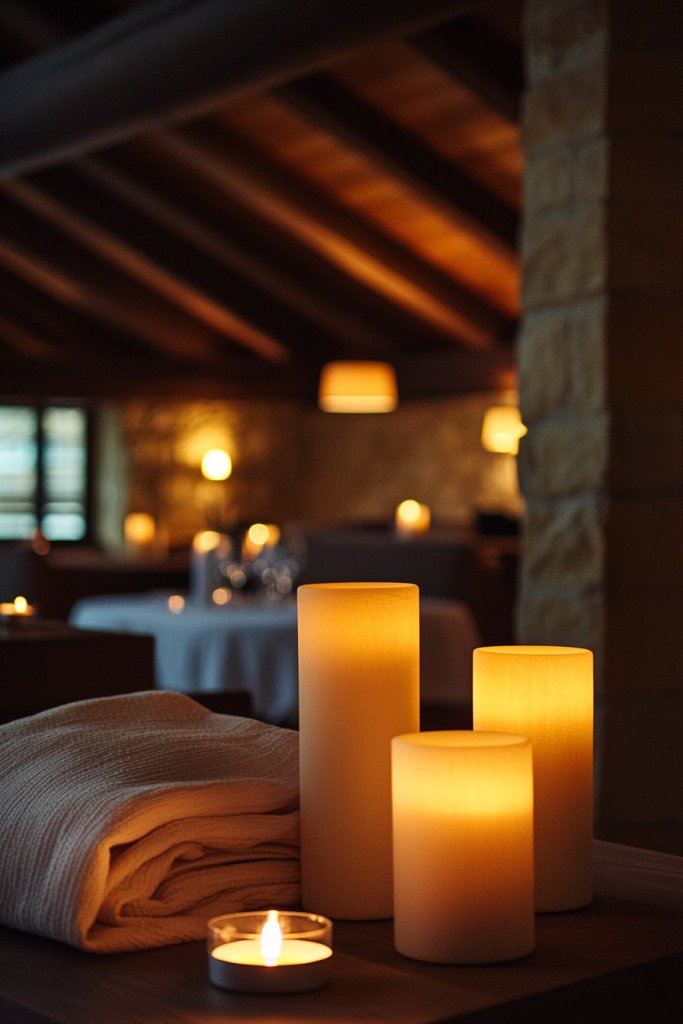
Lighting in Wabi Sabi interiors plays a vital role in creating a warm, inviting ambiance that enhances the space’s understated beauty. Soft, dimmed lighting accentuates textures and natural materials, fostering a sense of calm.
Recommended Products to replicate this idea
| # | Preview | Product | |
|---|---|---|---|
| 1 |

|
Fenmzee Bedside Table Lamp for Bedroom - 3 Way Dimmable Touch Lamp USB C Charging Ports and AC... | Check Latest Price |
| # | Preview | Product | |
|---|---|---|---|
| 1 |

|
Candlestick Holders Taper Candle Holders, Romadedi Gold Candle Stick Candle Holder for Table... | Check Latest Price |
Imagine a room illuminated by a few warm-toned lamps with dimming capabilities—perhaps a ceramic table lamp with a textured surface or a woven pendant with a warm glow. Candles placed on side tables or shelves add flickering, gentle light that dances across surfaces, highlighting the imperfect textures and muted colors.
The overall lighting is subdued, avoiding harsh brightness, which allows shadows and highlights to emphasize the space’s organic qualities. The atmosphere feels cozy, intimate, and serene, perfect for reflection or unwinding after a busy day.
To recreate this ambiance, opt for warm LED bulbs or incandescent bulbs in lamps with natural or handcrafted finishes. Use lampshades made from linen, burlap, or paper to diffuse the light softly.
Incorporate candles—preferably unscented or with subtle, natural scents—placed in simple holders or ceramic dishes. Keep lighting levels low and adjustable, so you can tailor the mood as needed. This layered, gentle lighting approach enhances the subtle elegance and tactile richness of a Wabi Sabi-inspired space.
9. Incorporate Natural Stone Elements in Floors and Accents
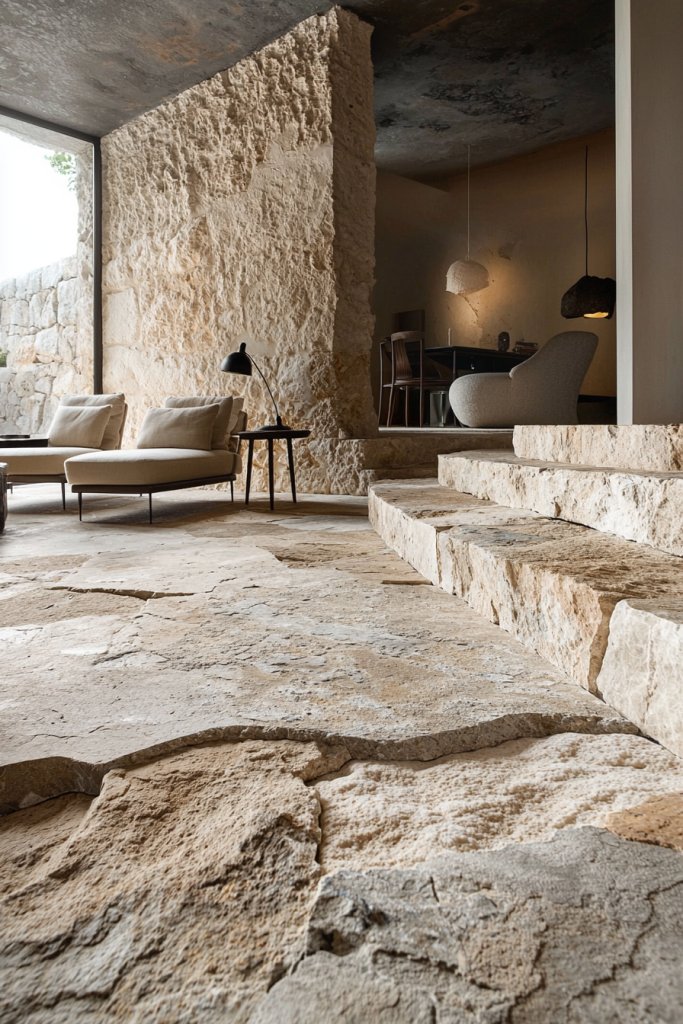
Natural stone adds an earthy, textured element that grounds a Wabi Sabi interior, emphasizing natural beauty and imperfection. Its organic variations and muted tones reinforce the connection to nature and time-worn aesthetics.
Recommended Products to replicate this idea
| # | Preview | Product | |
|---|---|---|---|
| 1 |

|
Hacaroa 6 Pieces Slate Cheese Board, 12" x 8" Black Charcuterie Boards Natural Slate Stone Plate... | Check Latest Price |
| # | Preview | Product | |
|---|---|---|---|
| 1 |

|
Novogratz Waverly 64 Inch Electric Fireplace with Mantel, Replaceable Fireplace Insert Heater,... | Check Latest Price |
Picture a slate or limestone floor with uneven, slightly textured surfaces that show natural veining and color variations—deep grey, warm beige, or cool taupe. Alternatively, incorporate stone accents like a rough-hewn stone fireplace, a small tabletop sculpture, or a countertop with unpolished edges.
These elements introduce tactile richness and visual depth, with irregularities and imperfections that tell a story of natural aging. The feel of stone underfoot or in hand adds a grounding, authentic quality that invites appreciation of nature’s artistry.
To implement, choose natural stone tiles or slabs from local suppliers or sustainable sources. For flooring, opt for unpolished or lightly honed finishes to preserve their natural texture.
Small accents like coasters, planters, or sculptures can be crafted from rough-cut stone or slate. If stone isn’t feasible, consider faux options made from textured concrete or ceramic with a natural finish. These elements create a subtle yet impactful connection to the natural world, reinforcing the Wabi Sabi aesthetic’s celebration of imperfect, aged beauty.
10. Use Worn-In Rugs with Soft, Muted Patterns for Cozy Accents
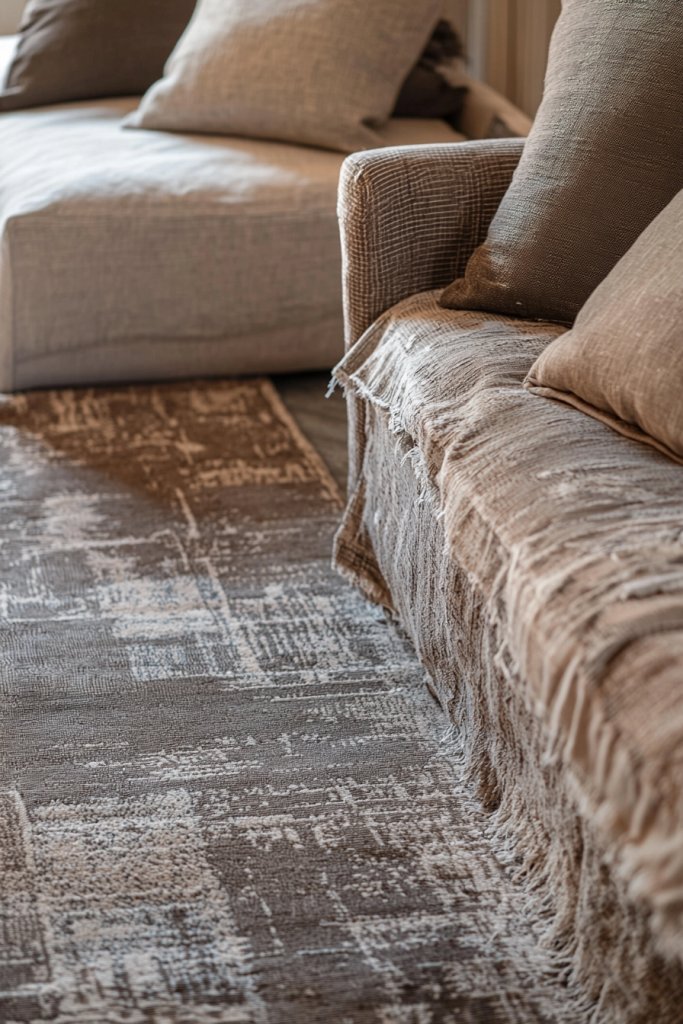
Creating a warm, inviting atmosphere in a modern wabi sabi interior often hinges on tactile elements like rugs. Worn-in rugs with gentle, muted patterns instantly evoke a sense of history and comfort, making your space feel lived-in and effortlessly beautiful.
Recommended Products to replicate this idea
| # | Preview | Product | |
|---|---|---|---|
| 1 |

|
SAFAVIEH Area Rug 9x12 - Natura Collection - Large - Ivory, Handmade Wool Blend, Textured Design,... | Check Latest Price |
| # | Preview | Product | |
|---|---|---|---|
| 1 |

|
SAFAVIEH Area Rug 5x8 - Natural Fiber Collection - Natural Brown, Handmade Jute, Farmhouse Style,... | Check Latest Price |
Think of a softly faded jute or wool rug in shades of beige, gray, or dusty blue, with subtle irregularities in the weave that tell a story of age and character. The texture should be plush yet slightly coarse, inviting bare feet and adding a layer of coziness underfoot.
These rugs serve as grounding focal points that soften the harder surfaces around them, enhancing the overall sense of subtle elegance. Visualize walking into a room where a slightly frayed, handwoven rug lies beneath a low, organic coffee table, its muted colors blending seamlessly with earthy tones on the walls and furniture.
The fibers feel rough yet comforting, with a faint smell of natural fibers and aged wood. The pattern is intentionally understated, perhaps a gentle stripe or irregular geometric shape that complements the imperfect beauty of the space.
The rug’s worn look balances modern minimalism with rustic charm, creating a cozy, inviting ambiance that encourages relaxation and reflection. To recreate this look, start by sourcing a worn-in or distressed rug made from natural materials like jute, sisal, or wool.
You can find authentic vintage rugs or choose new ones with intentionally faded or frayed finishes. Lay the rug in a central area or under a seating zone to anchor the space.
Pair it with simple, organic furniture—think a linen sofa or wooden chairs—and keep accessories minimal. Regular gentle vacuuming and spot cleaning will keep it looking charming without losing its aged character, making it a practical yet beautiful addition.
11. Display Wabi Sabi-Inspired Decor with a Focus on Simplicity
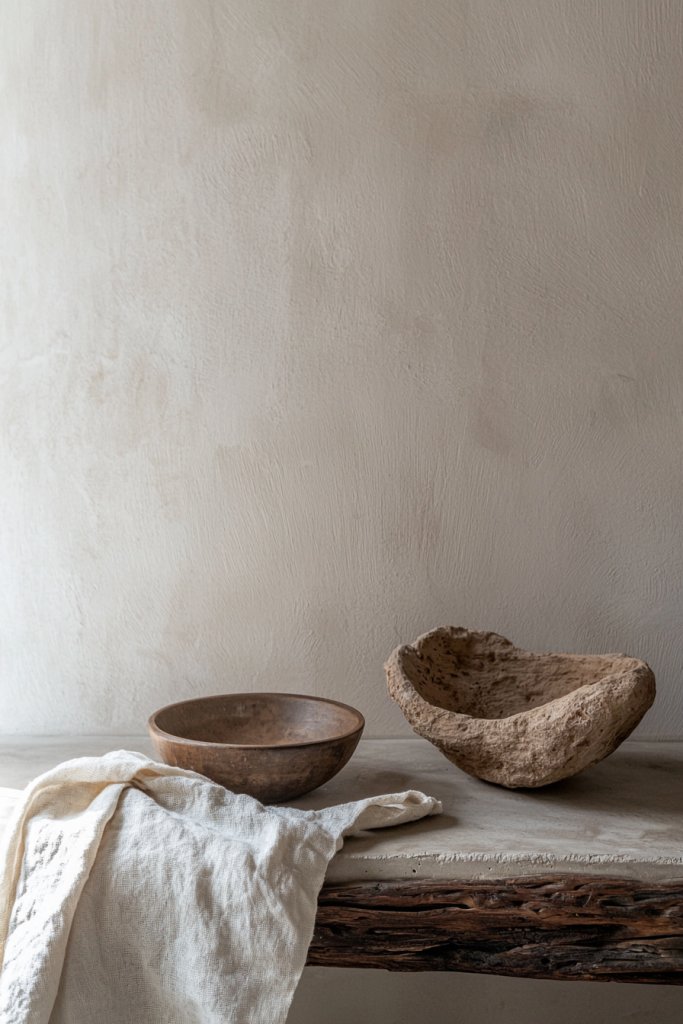
In a modern wabi sabi interior, less is truly more. Showcasing decor that emphasizes simplicity and imperfection helps create a calming, authentic environment.
Recommended Products to replicate this idea
| # | Preview | Product | |
|---|---|---|---|
| 1 |

|
Mulberry Lane Co. Handmade Black Vase - 9.5'' Tall, Black Ceramic Vase, Antique Decor with 3 Ear... | Check Latest Price |
| # | Preview | Product | |
|---|---|---|---|
| 1 |

|
NOVICA Romantic Wood Sculpture, Brown, 8" Tall 'Eternity Of Love' | Check Latest Price |
The key is selecting a few meaningful pieces that embody natural beauty—think handmade ceramics, rough-hewn wooden bowls, or minimalist sculptures—carefully arranged to highlight their unique textures and forms. Avoid clutter and overly ornate objects; instead, focus on pieces that evoke a sense of calm and appreciation for the imperfect and transient.
This understated approach allows natural materials and subtle imperfections to shine, fostering a serene and balanced space. Imagine a low shelf displaying a single, handcrafted ceramic vase with an uneven glaze, paired with a simple linen cloth and a small, weathered driftwood sculpture.
The decor’s neutral hues—earthy browns, soft whites, and muted grays—complement each other, emphasizing natural simplicity. The arrangement feels unforced, as if each piece was chosen with care and purpose.
The overall visual effect is one of understated elegance, inviting viewers to appreciate the beauty in imperfection and quiet moments of reflection. To implement this, select a handful of authentic, handcrafted objects that resonate with your aesthetic—ceramics, stones, or textiles—and display them in a clean, uncluttered space.
Keep surfaces free of excess decor, allowing each piece to breathe. Opt for natural materials and neutral tones to maintain harmony. Regularly curate and rotate your collection to keep the display fresh and meaningful, ensuring that every object adds intentionality and tranquility to your environment.
12. Create Nooks with Raw, Unfinished Materials for Meditation or Reflection
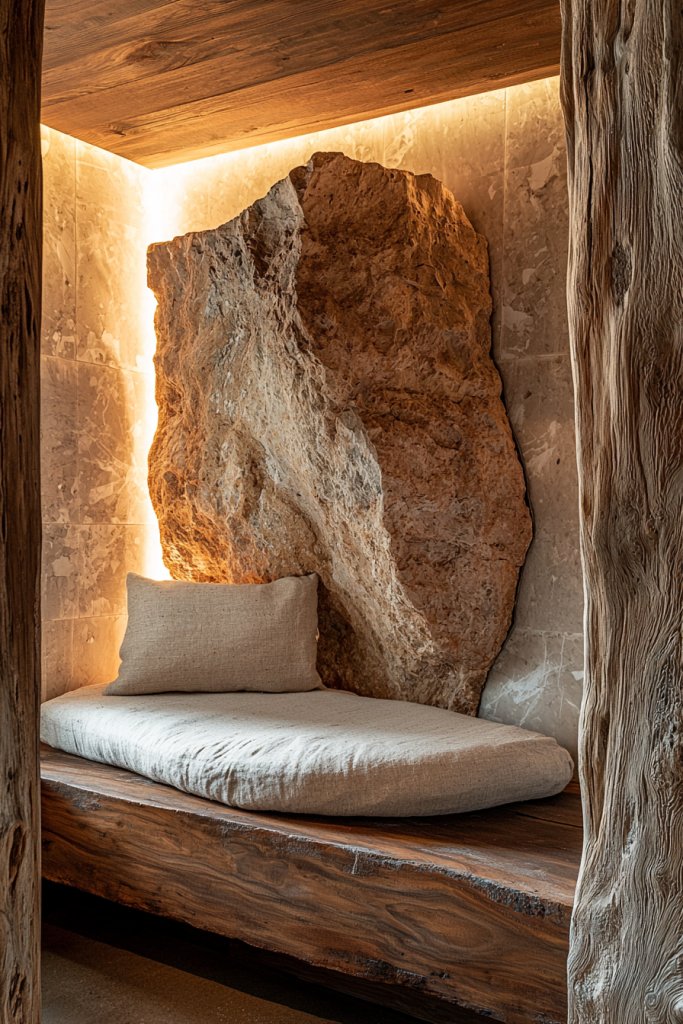
Designing intimate nooks with raw, unfinished materials invites calm, introspection, and a sense of connection to nature. These cozy corners serve as personal retreats where the beauty of simplicity and imperfection can be appreciated.
Recommended Products to replicate this idea
| # | Preview | Product | |
|---|---|---|---|
| 1 |

|
Sawmill Long Wood Bench, 43" Farmhouse Entryway Bench for Living Dining Room, Rustic Entry Way... | Check Latest Price |
| # | Preview | Product | |
|---|---|---|---|
| 1 |

|
FOTOSOK 6-Tier Bamboo Shelf, Bamboo Bookcase with Adjustable Shelves, Free Standing Storage Shelf... | Check Latest Price |
Use elements like rough-hewn wooden benches, unpolished stone accents, or unfinished drywall surfaces to evoke a raw, organic feel. Incorporate soft, tactile textiles such as handwoven throws or linen cushions to add comfort without detracting from the natural aesthetic.
The space should feel unpretentious, encouraging mindfulness and quiet reflection. Visualize a small alcove with a simple wooden platform or a vintage wooden crate as a seat, topped with a soft, textured blanket.
The surrounding walls are left intentionally rough, with visible plaster or exposed brick, creating a tactile contrast with the plush textiles. A small, unglazed ceramic candle holder or a rough stone sculpture adds subtle visual interest.
The space feels grounded, earthy, and inviting—a perfect spot for meditation, journaling, or simply unwinding from the day, all within a setting that celebrates natural, unrefined beauty. To create this, choose raw, unfinished materials like reclaimed wood, unpolished stones, or exposed drywall.
Build or repurpose existing furniture with minimal treatment—no paint or varnish—and layer with handmade or textured textiles for comfort. Keep the area uncluttered, adding only a few meaningful objects that inspire tranquility.
Focus on natural lighting—such as filtered sunlight through linen curtains—to enhance the space’s serenity. This simple yet intentional nook becomes a sanctuary for mindfulness and gentle reflection.
13. Choose Modular, Multi-Functional Furniture for Practical Minimalism
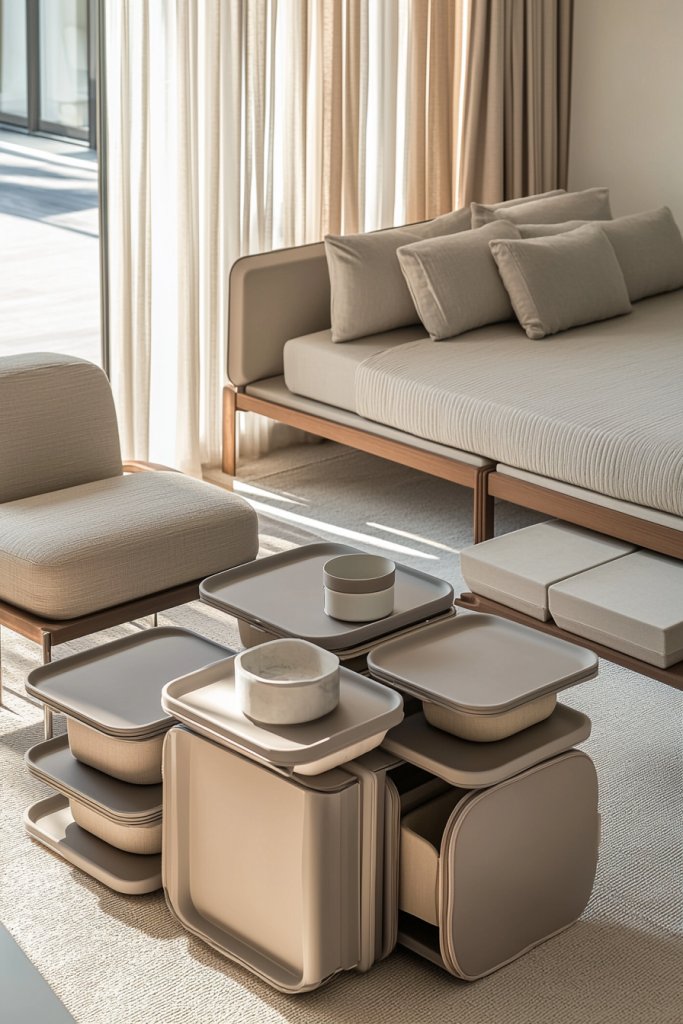
In a modern wabi sabi interior, furniture that’s both modular and multi-functional aligns perfectly with the philosophy of simplicity and adaptability. These pieces maximize utility without cluttering the space, allowing for flexibility as your needs evolve.
Recommended Products to replicate this idea
| # | Preview | Product | |
|---|---|---|---|
| 1 |

|
Mavivegue Bookcase, 18-Cube Extra Large Book Shelf, DIY Cube Storage Organizer for Bedroom,... | Check Latest Price |
| # | Preview | Product | |
|---|---|---|---|
| 1 |

|
WOHOMO Folding Coffee Table Rustic Small Coffee Tables for Living Room Farmhouse Portable Table... | Check Latest Price |
Think of a sleek, wooden storage bench that doubles as seating or a fold-away table that can be tucked into a corner when not in use. Such furniture often features clean lines, organic shapes, and natural finishes that highlight the beauty of raw materials.
Their understated design encourages a clutter-free, serene environment. Imagine a low-profile, modular shelving system crafted from unfinished oak, which can be rearranged into different configurations—bookshelves, room dividers, or display units.
It’s paired with a simple, multi-purpose coffee table that can be expanded or collapsed as needed. The furniture’s natural textures and muted tones blend seamlessly into the space, creating a calm, cohesive aesthetic.
The overall effect is functional minimalism that emphasizes practicality while maintaining an organic, imperfect charm that resonates with wabi sabi principles. To implement, look for versatile furniture pieces made from natural materials—wood, bamboo, or metal with a vintage finish.
Prioritize items that can serve multiple purposes, such as storage ottomans, nesting tables, or foldable desks. Assemble or customize pieces as needed, keeping the design simple and free of unnecessary ornamentation.
With a focus on quality and craftsmanship, these pieces will age gracefully, adding character and longevity to your space. This approach promotes a clutter-free lifestyle rooted in mindful, intentional living.
14. Highlight Textural Contrasts Through Layered Textiles and Surfaces
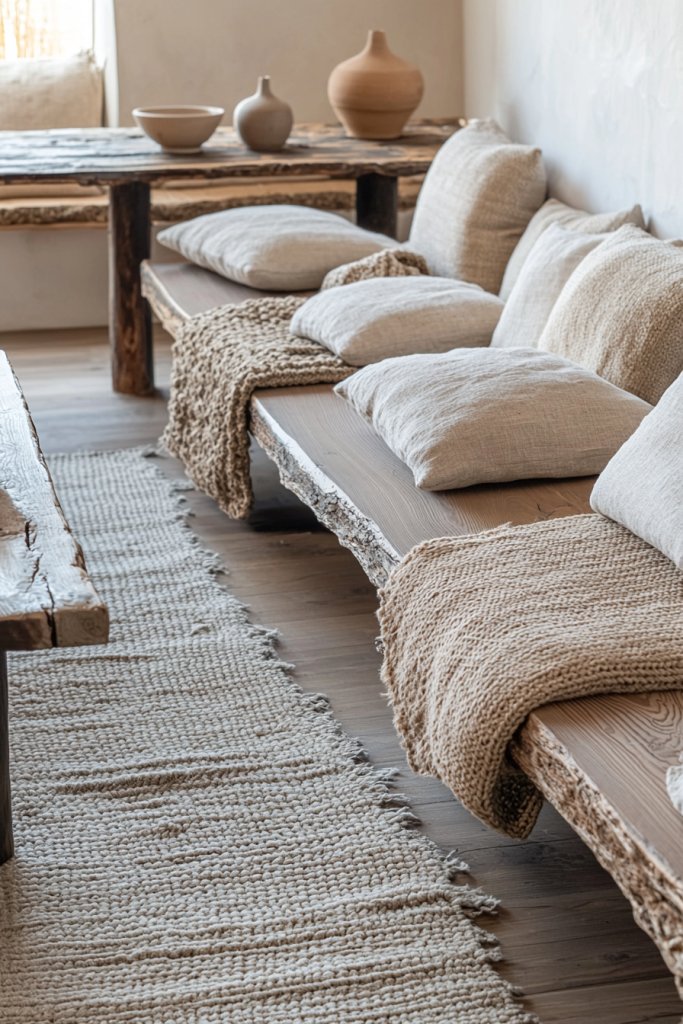
Creating visual interest in a modern wabi sabi space often relies on contrasting textures—smooth, rough, soft, and coarse—that add depth and tactile richness. Layering textiles like chunky knit throws, linen cushions, and woven rugs over hard surfaces such as unfinished wood, stone, or concrete creates a harmonious balance that embodies natural imperfection.
Recommended Products to replicate this idea
| # | Preview | Product | |
|---|---|---|---|
| 1 |

|
Foindtower Pack of 2, Decorative Linen Soild Throw Pillow Covers Soft Accent Cushion Case Boho... | Check Latest Price |
| # | Preview | Product | |
|---|---|---|---|
| 1 |

|
S & L Homes Jute Cotton Hand Woven Natural Farmhouse Area Rug for Living Room - Rustic Vintage... | Check Latest Price |
These contrasts invite touch and encourage a sensory connection to the environment, making the space feel cozy yet grounded. Picture a neutral-toned room where a soft, oatmeal-colored linen cushion sits atop a rough, weathered wooden bench.
Nearby, a chunky knit throw in warm cream is casually draped, contrasting with the sleekness of a polished concrete floor. The layered textiles provide visual warmth and softness, while the underlying surfaces—raw wood, unpolished stone—offer a textural counterpoint.
The interplay of these elements enhances the space’s organic, imperfect beauty and evokes a calm, contemplative mood. To achieve this, select a mix of textiles with varied textures and keep the color palette subdued for harmony.
Use woven rugs, knitted blankets, and linen or hemp cushions to create layers that invite touch. Combine these with raw, natural surfaces like unfinished wood furniture or stone accents.
Experiment with stacking or draping textiles in an intentionally imperfect way to enhance the wabi sabi aesthetic. This layered approach adds visual complexity and tactile comfort, transforming your space into a sanctuary of subtle elegance.
15. Incorporate Raw Metal Accents with a Slightly Vintage Feel
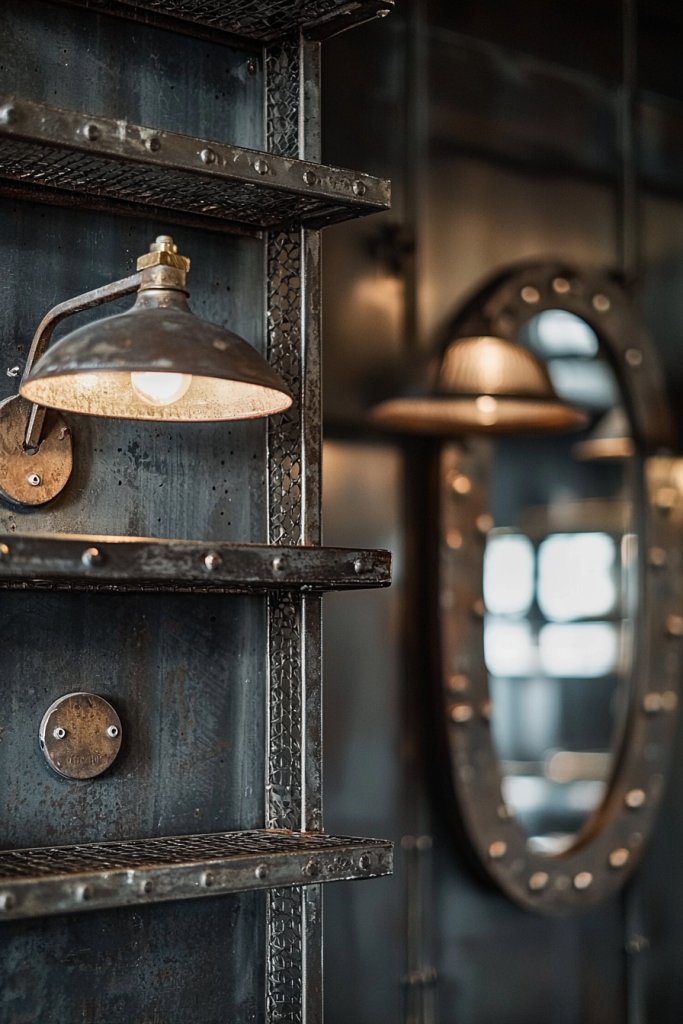
Adding raw metal accents brings an industrial yet warm touch to modern Wabi Sabi interiors, infusing a space with subtle vintage charm. This approach highlights imperfect finishes and distressed textures that amplify the beauty of aged materials.
Recommended Products to replicate this idea
| # | Preview | Product | |
|---|---|---|---|
| 1 |

|
SAYGOER Black Coffee Table Simple Modern Rectangular Center Table Open Space Minimalist for... | Check Latest Price |
| # | Preview | Product | |
|---|---|---|---|
| 1 |

|
Yanxia Set of 6 - Elegant Vintage Bloom Antique Brass Cabinet Knobs with Backplate, Drawer Pulls... | Check Latest Price |
It’s a way to create visual interest without overwhelming the simplicity, making your space feel layered and authentic. Imagine a weathered steel coffee table with a matte, slightly oxidized surface, or vintage brass hardware on cabinets that shows gentle patina and wear.
These metallic elements often feature irregularities—such as uneven edges or imperfect welds—that celebrate craftsmanship and history. When paired with natural fabrics and textured ceramics, these accents deepen the sense of rustic elegance, adding a tactile richness and visual contrast.
The overall atmosphere feels both grounded and timeless, with a hint of history whispering through each piece. To incorporate raw metal accents, start by choosing pieces like a reclaimed metal lamp with a distressed finish, or a vintage metal sculpture as a focal point.
You can find affordable options at flea markets or vintage stores, or even craft your own with basic welding skills. Keep the metal finishes intentionally imperfect—allowing rust, patina, or uneven paint to show. Pair these with natural wood or linen to balance the coldness of metal, creating a cohesive, lived-in aesthetic that’s effortlessly stylish and authentically Wabi Sabi.
16. Use Subtle, Organic Shapes in Light Fixtures and Hardware
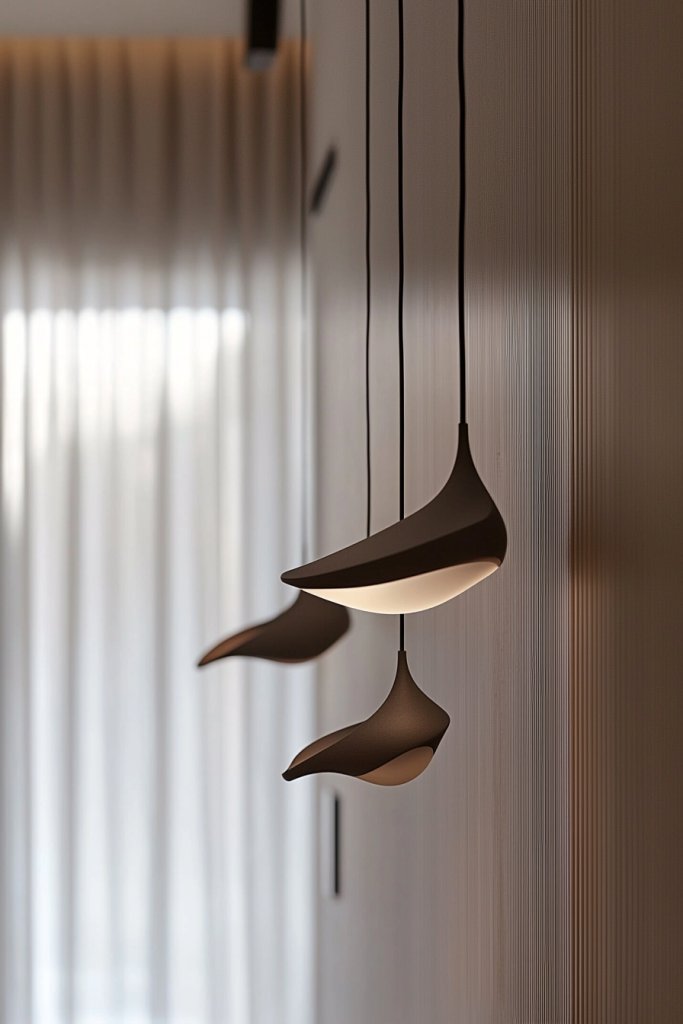
In Wabi Sabi interiors, lighting fixtures and hardware with organic, flowing shapes evoke a sense of natural harmony and understated elegance. These soft, asymmetrical forms mimic nature’s imperfections, providing a gentle visual rhythm that complements the minimalist, imperfect beauty of the space.
Recommended Products to replicate this idea
| # | Preview | Product | |
|---|---|---|---|
| 1 |
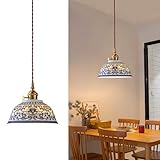
|
7in Ceramic Pendant Light, Chinese Blue and White Porcelain Pendant Light fixtures, Bedside... | Check Latest Price |
| # | Preview | Product | |
|---|---|---|---|
| 1 |

|
Ravinte 30 Pack 5 Inch Cabinet Pulls Brushed Brass Stainless Steel Kitchen Drawer Pulls Cabinet... | Check Latest Price |
It’s about choosing details that feel handcrafted and authentic rather than overly geometric or polished. Picture a pendant light with a slightly uneven, hand-formed ceramic shade that curves gently like a pebble, or brushed brass drawer pulls with irregular contours that feel organic to the touch.
These elements serve as quiet focal points, subtly drawing the eye without overwhelming the overall calm aesthetic. The shapes tend to be rounded, asymmetrical, and imperfect—mirroring the natural world and encouraging a sense of serenity and authenticity in the environment.
When paired with warm, dim lighting, these fixtures emphasize the tactile and visual softness that defines Wabi Sabi. To incorporate these shapes, start by exploring handcrafted ceramics or metal hardware with irregular contours from artisans or DIY sources.
Look for pendant lights with uneven, undulating surfaces or vintage-inspired fixtures with a slightly warped appearance. Ensure the hardware is functional but retains its natural, imperfect form.
Keep the color palette warm—think matte black, brushed brass, or muted earth tones—to enhance the organic feel. These subtle details will elevate your space with a gentle, natural elegance aligned with Wabi Sabi principles.
17. Integrate Natural Light with Simple Window Coverings in Linen or Burlap

Maximizing natural light is a cornerstone of modern Wabi Sabi interiors, emphasizing simplicity and the beauty of natural materials. Using light, airy window coverings made from linen or burlap allows sunlight to filter softly into the space, creating a calm, inviting glow that enhances textures and imperfect surfaces.
The focus is on understated, functional design that celebrates the natural qualities of the fabric and the light it diffuses. Visualize sheer linen curtains in a neutral shade that gently sway with the breeze, casting a warm, diffuse glow across textured walls and organic furnishings.
The fabric’s subtle weave adds a tactile element, inviting touch and deeper appreciation of natural materials. In the early morning or late afternoon, this filtered light highlights the irregularities of stone surfaces or worn wood, adding depth and serenity to the environment.
The overall effect is a peaceful, contemplative space that feels connected to nature’s rhythms. To implement this, choose simple, unadorned linen or burlap curtains that are easy to hang and maintain.
Opt for light, neutral colors like off-white, taupe, or soft gray to keep the look understated. Avoid heavy drapes or overly decorative treatments—favor minimal hardware such as wooden or metal rods.
Regularly clean the fabric to maintain its natural texture and softness, and position furniture to maximize the natural light flow. This approach creates a luminous, tranquil atmosphere that embodies the Wabi Sabi ethos of understated beauty.
18. Incorporate Subdued, Muted Art Pieces with Wabi Sabi Aesthetic
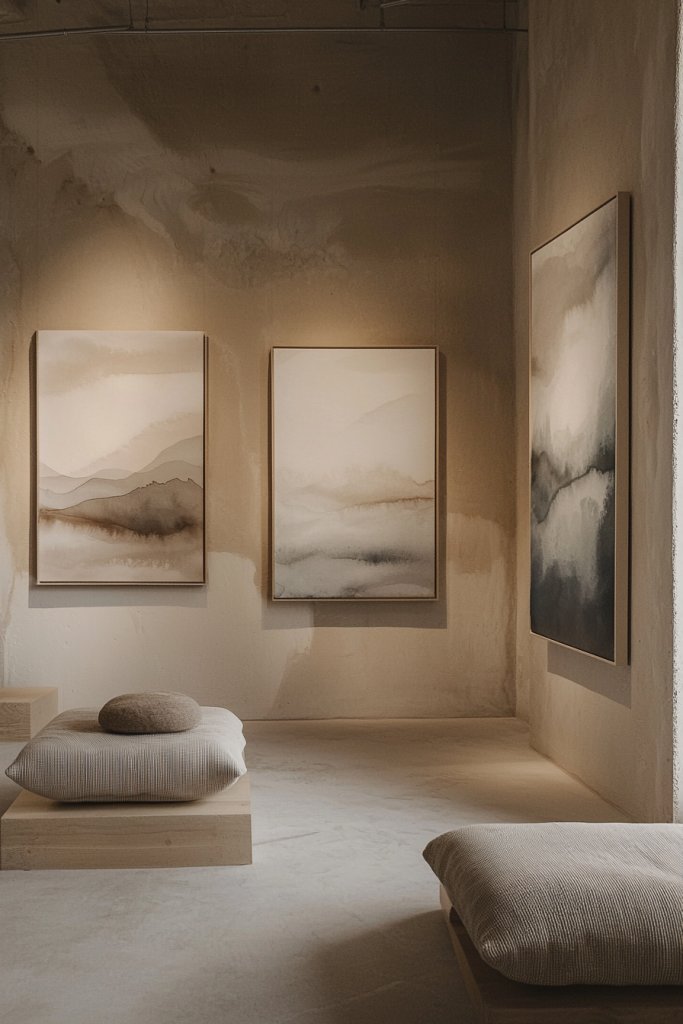
In Wabi Sabi interiors, art isn’t about perfection or bold statements but about subtlety, imperfection, and emotional resonance. Incorporating subdued, muted art pieces—such as soft watercolor landscapes, monochromatic ink drawings, or textured ceramic sculptures—enhances the aesthetic without overpowering the calm, minimalist environment.
Recommended Products to replicate this idea
| # | Preview | Product | |
|---|---|---|---|
| 1 |

|
Watercolour Landscapes for the Absolute Beginner (ABSOLUTE BEGINNER ART) | Check Latest Price |
| # | Preview | Product | |
|---|---|---|---|
| 1 |

|
Mastering Sculpture: The Figure in Clay: A Guide to Capturing the Human Form for Ceramic Artists... | Check Latest Price |
These pieces serve as quiet focal points that evoke reflection and appreciation for imperfections. Imagine a simple, hand-painted watercolor in soft earth tones hanging on a textured wall, or a worn-in ceramic bowl with irregular glaze drips displayed on a shelf.
These artworks, often featuring natural motifs or abstract forms, emphasize simplicity and authenticity. The goal is to create a space where art complements the imperfect beauty of the surroundings, encouraging mindfulness and tranquility.
The muted palette and understated presentation allow the textures and subtle details to shine, fostering a sense of harmony and subtle elegance. To incorporate these art pieces, look for handmade or vintage items from local artisans or craft markets.
Choose artworks in subdued hues—think muted greys, gentle browns, or soft blues—that blend seamlessly into your space. Keep framing simple or opt for unframed pieces for a more raw, organic feel.
Position artworks thoughtfully at eye level or within natural sightlines to enhance their contemplative effect. This approach nurtures a quiet, refined aesthetic rooted in the authentic, imperfect beauty of Wabi Sabi.
19. Use Reclaimed or Upcycled Materials to Add Character and Sustainability

Incorporating reclaimed or upcycled materials embodies the Wabi Sabi philosophy of sustainability, imperfection, and character. Using salvaged wood, vintage textiles, or repurposed metal pieces introduces a sense of history and uniqueness to your interior.
Recommended Products to replicate this idea
| # | Preview | Product | |
|---|---|---|---|
| 1 |

|
Wnutrees 43" Farmhouse Solid Wood Coffee Table, Rustic Rectangular Center Table for Living Room,... | Check Latest Price |
| # | Preview | Product | |
|---|---|---|---|
| 1 |

|
Seoulful Vintage Korean Saekdong Pin Cushion - Traditional Colorful Patchwork Needle Holder -... | Check Latest Price |
These materials often feature signs of wear, patina, or irregularities that enhance their beauty and authenticity, creating a space rich with stories and natural charm. Visualize a reclaimed wood coffee table with visible knots and uneven edges, or upcycled metal racks with a slightly rusted finish.
Vintage fabrics, such as faded linen or worn leather, can be transformed into cushions or wall hangings, adding softness and warmth. These elements contribute to a layered, textured environment that feels lived-in and genuine.
The overall aesthetic is one of mindful reuse, where every imperfection adds value and depth, aligning perfectly with Wabi Sabi’s celebration of natural aging and imperfection. Getting started is straightforward: source reclaimed or upcycled materials from thrift stores, salvage yards, or online marketplaces.
Embrace the imperfections—allow rust, scratches, or faded colors to be part of their charm. Incorporate these pieces as furniture, decor, or textiles, and combine them with natural fibers and neutral tones for cohesion. This eco-friendly approach not only enhances the character of your space but also aligns with the sustainable values at the heart of Wabi Sabi.
20. Balance Empty Space with Thoughtful Placement to Enhance Subtle Elegance
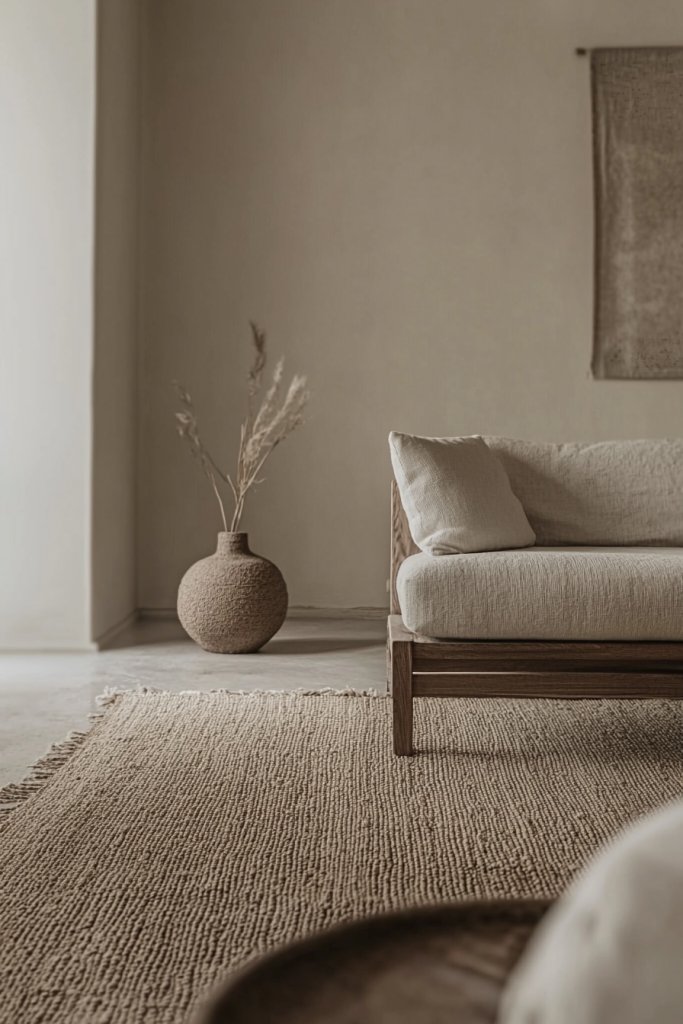
In modern Wabi Sabi interiors, the artful use of empty space is essential for creating a serene, balanced atmosphere that exudes subtle elegance. It’s about knowing when to let the space breathe, allowing your carefully selected decor to stand out and breathe within the room’s flow.
Recommended Products to replicate this idea
| # | Preview | Product | |
|---|---|---|---|
| 1 |

|
Modern Floor Lamp Simple Design with White Shade, Foot Pedal Switch, 60" Small Tall Lamps for... | Check Latest Price |
| # | Preview | Product | |
|---|---|---|---|
| 1 |

|
Vanselia Ceramic Flower Vase Home Decor - Large Farmhouse Table Vases Rustic Vintage Living Room... | Check Latest Price |
Imagine a living room with a modest, low-slung sofa in soft, neutral linen, positioned with ample space around it. The walls are intentionally left uncluttered, with only a simple, handcrafted ceramic vessel on a side table.
There’s a quiet stillness here, with natural light pouring in through linen curtains, softly illuminating the space and highlighting its imperfections—like a slightly uneven wooden floor or a weathered stone accent wall. This balance between filled and empty areas creates a calming visual rhythm that invites reflection and mindfulness.
To achieve this, start by decluttering your space—remove excess items and focus on a few meaningful pieces. Prioritize placement that allows for breathing room, such as placing furniture away from walls to create visual depth.
Use negative space intentionally around focal points like a textured ceramic bowl or a woven textile, ensuring these items aren’t crowded. Incorporate open areas in your floor plan, and avoid filling every corner, allowing your space to feel calm, balanced, and subtly sophisticated. Simple, mindful arrangement is key to capturing that perfect Wabi Sabi harmony.
Conclusion
By embracing imperfect textures, natural materials, muted tones, and thoughtful simplicity, these modern wabi sabi interior ideas invite you to create serene, authentic spaces full of subtle elegance. Experiment with weathered woods, handcrafted ceramics, and layered textiles to reflect beauty in imperfection.
Incorporate natural light, raw accents, and meaningful decor to cultivate a calming atmosphere that resonates with your personal style. Start transforming your home today—embrace the imperfect, and let your space tell a story of understated beauty and mindful living.
Last update on 2025-09-21 / Affiliate links / Images from Amazon Product Advertising API
Leave a Reply